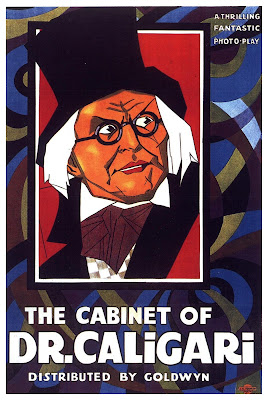Das Cabinet Des Dr Caligari
Das Cabinet Des Dr Caligari (1920) directed by Robert Wiene is a silent German horror which shows strong influences of German Expressionism in its theme - an art movement which was formed in the 1910's to show how Germany felt during the First World War - which gives the horror film its distorted, creepy and disfigured appearance.
An elder man arrives in Holstenwall for the town fair in order to show off his somnambulist who has been asleep throughout his 23 years. The film then begins to unravel in the point of view of one of the main protagonists, Francis whom throughout the whole film is encapsulated in solving the murders taking place since the arrival of the somnambulist and his master. Francis becomes hell-bent of piecing together the cases and begins to become closer to solving the cases which later results in Francis finding himself following Dr Caligari to a mental institute - which he is director of. Francis then continues to discover that Dr Caligari has an obsession over the somnambulist and the studies which speak of the possible manipulation of a somnambulist. Francis fully unravels the murders and picks apart the fear which Dr Caligari had cast across Holstenwall. However Wiene then shifts the story back to how it begun, from where it begins to unravel that Francis is in fact a patient in the mental institute who has created the whole scenario within his mind and the isolation of his cell.
From watching the film and researching the art movement which inspired the setting of the film, some may come to the conclusion that the film itself is portraying the isolation Germany felt during the WW1. The audience following the plot twist could then infer from the theme that Francis' mental state leaves him isolated and scared -just like the setting of the film- as a result of the scenario which he conjures in his mind while confided and isolated in the asylum
It is clear throughout that this film has been so influential and inspiring to many directors such as Tim Burton. In Tim Burton's work from Beetle Juice to Edward Scissor Hands to The Corpse Bride you can consistently see similarities to Wiene's work in both the set designs and characters, showing how far Wiene's work has influenced and defined many genres, especially horror.



A well-written and insightful review Danni :)
ReplyDeleteDon't forget that you need to support your discussion with at least 3 quotes form published sources (online film reviews, books etc). These need to be referenced using the Harvard method, details of which you can find here - http://community.ucreative.ac.uk/Harvard-Referencing
You should also include some images (stills from the film for example) which are labelled and captioned, and then referenced in an illustrations list; again, see the referencing guide.
I look forward to what you make of 'Metropolis' :)
Great review. I really enjoyed reading it. Ditto to what Jackie said about adding quotes, more images and referencing them. Give us a shout if you need any help. :)
ReplyDelete